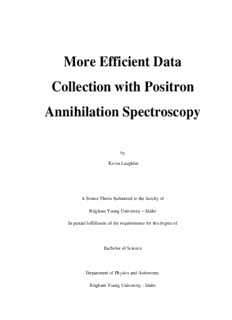Table Of ContentMore Efficient Data
Collection with Positron
Annihilation Spectroscopy
by
Kevin Laughlin
A Senior Thesis Submitted to the faculty of
Brigham Young University – Idaho
In partial fulfillment of the requirements for the degree of
Bachelor of Science
Department of Physics and Astronomy
Brigham Young University - Idaho
Copyright © Kevin Laughlin
All Rights Reserved
i
Brigham Young University – Idaho
DEPARTMENT APPROVAL
Of a Senior Thesis submitted by
Kevin Laughlin
This thesis has been reviewed by the research advisor, research coordinator, and
department chair and has been found to be satisfactory.
Date Evan Hansen, Advisor
Date Jon Johnson, Committee Member
Date Stephen McNeil, Research Coordinator
ii
ABSTRACT
Kevin Laughlin
Department of Physics and Astronomy
Bachelor of Science
Positron Annihilation Spectroscopy (PAS) is a non-invasive way of finding the
density of defect in materials. This is important because the amount of defects
in a material can greatly alter its integrity. The S-parameter is an indicator of
the defect density, and is compared with an S-parameter of a sample with a
known defect density. The placement of the source compared to the detector
can cause artificial changes in the S-parameter, which will cause problems
with the interpretation of the data. PAS can also be used to find elemental
differences. Defects in a material can be removed or created in localized
areas. They can also be detected, and can be distinguished from areas of low
defect density using the detector and acquisition setup. The placement of the
source compared to the detector as well as the data collection time are more of
a software then geometric problem, and can be easily solved.
iii
Acknowledgments
I would like to thank all of my class mates that helped keep me sane and make things fun.
I’d also like to thank my family for supporting me. I’d especially like to thank Dr. Evan
Hansen, it was his love of physics that helped me realize that physics is what I want to do. If
it weren’t for him, I would not be where I am today.
iv
Contents
1 Introduction 1
1.1 History 1
1.2 Positron Annihilation Spectroscopy 2
1.3 Purpose 5
1.4 How it works 5
2 Experimental Set up 7
2.1 Detector and Acquisition Software 7
2.2 Positron source 8
2.3 Motors 8
3 Experiments 10
3.1 Different Copper Pieces 10
3.2 Different Materials 12
3.3 Altering Placement of Source 14
3.3.1 Pileup 15
3.3.2 Pole Zero 16
3.3.3 Geometry 19
3.3.4 A Fix to This Problem 20
4 Conclusion 22
4.1 Experimental Results 22
4.2 Future Work 22
4.3 Introducing Selected Defects 23
v
vi
Chapter 1: Introduction
1.1 History
The positron is the antimatter counterpart of the electron. The positron and
electron are identical in every way, except for charge. Paul Dirac first theorized
Positrons in 1928 in his paper “The quantum theory of the electron.” Positrons were
“seen” in the following years, but were mistaken as protons. It wasn’t until 1932 that
Carl D. Anderson discovered an unknown particle in a cloud chamber with the same
charge to mass ratio as the electron, but positively charged. Anderson coined the
phrase positron and received the Nobel Prize for his findings. Because the electron
and positron are anti-matter pairs, when an electron and a positron come in contact
they annihilate each other and give off two 511 keV gamma rays. The 511 keV
gamma rays come from their rest mass energies, and as known from Einstein’s most
famous equation . This means that when the electron positron pair
annihilate, their masses convert into energy in the form of gamma rays.
1
Figure 1 – This is a Feynman diagram showing how a positron and
electron annihilate, creating two roughly 511 keV gamma rays. [7]
1.2 Positron Annihilation Spectroscopy (PAS)
In PAS positrons are introduced into materials, where they will annihilate with
characteristic electrons of that material. Positrons often come from high-energy
sources and must slow down before they annihilate. In 1949, DeBenedetti et al [10]
discovered that the two gamma rays aren’t always 511 keV, when produced in a
material where the positrons have thermalized. Instead, these rays can be Doppler
shifted due to the overall momentum of the positron-electron pair right before they
annihilate. Both gamma rays will be 511 keV if the total momentum of the pair is
zero. The gamma rays will be Doppler shifted in the direction of momentum if the
total momentum is not zero. The electron causes most of the shifting energies. This
is because the positron typically thermalizes, and slowing down to low momentum.
2
The electrons that are closer to the nucleus have a higher momentum while the
electrons that are on the outer shell have a lower momentum.
Whether a positron annihilates in a vacancy in the material structure or not
will greatly change the probability of the energy shell of the electron it will with
which it will annihilate. This is because when there is a vacancy or hole in the atomic
structure, it is more energetically favorable for the positron to go to the vacancy. This
increases the probability of the positron annihilating with an outer shell electron that
has lower momentum. When there are no vacancies the positron will be more likely
to annihilate with a core electron then if there were vacancies. These core electrons
have higher momentum and will consequently increase the chance of the gamma rays
being Doppler shifted.
Figure 2 – The path that a positron is most likely to take before
annihilation. [6]
3
Description:Positron Annihilation Spectroscopy (PAS) is a non-invasive way of finding the source compared to the detector as well as the data collection time are more .. Figure 14 – The picture on the right is a drawing of when a gamma ray

